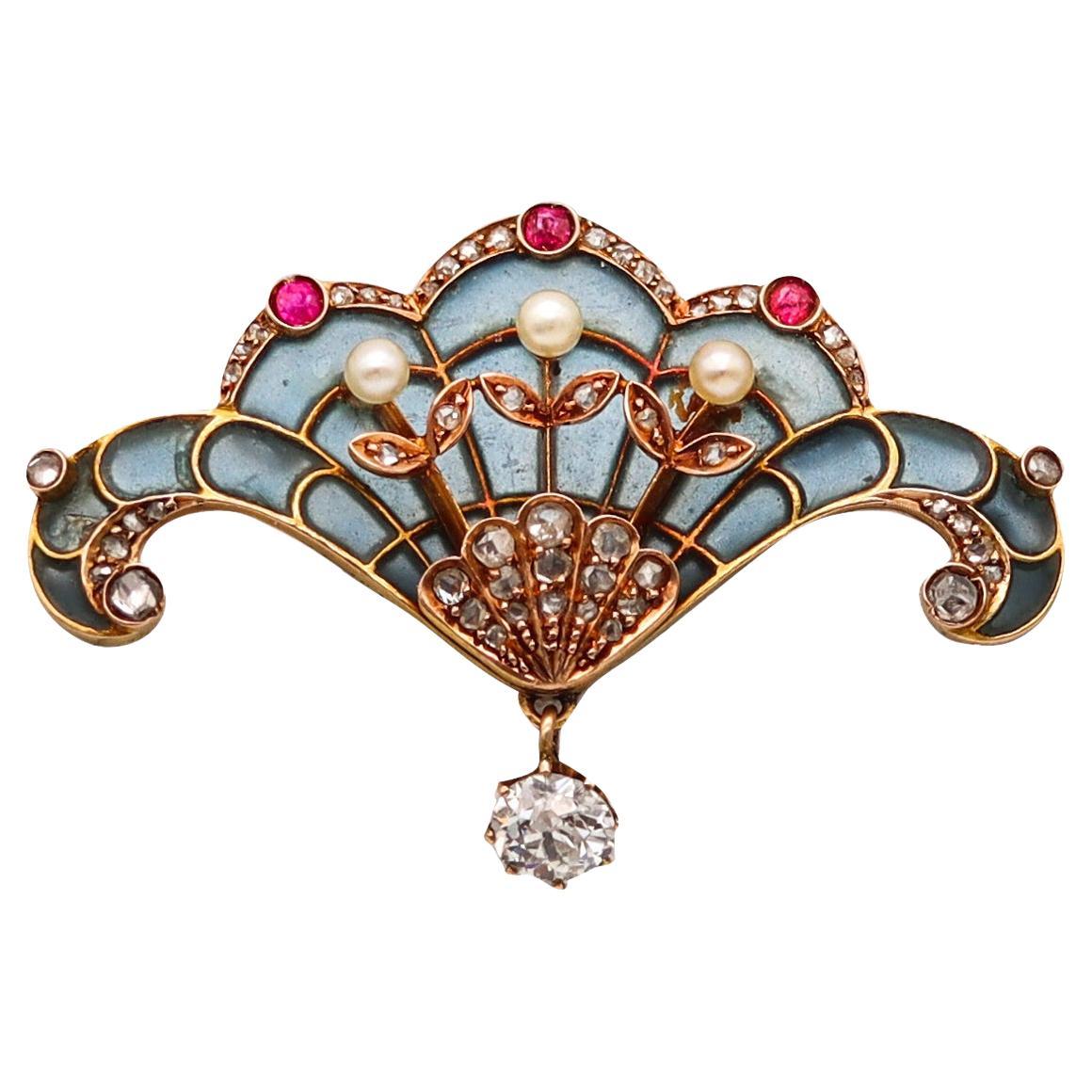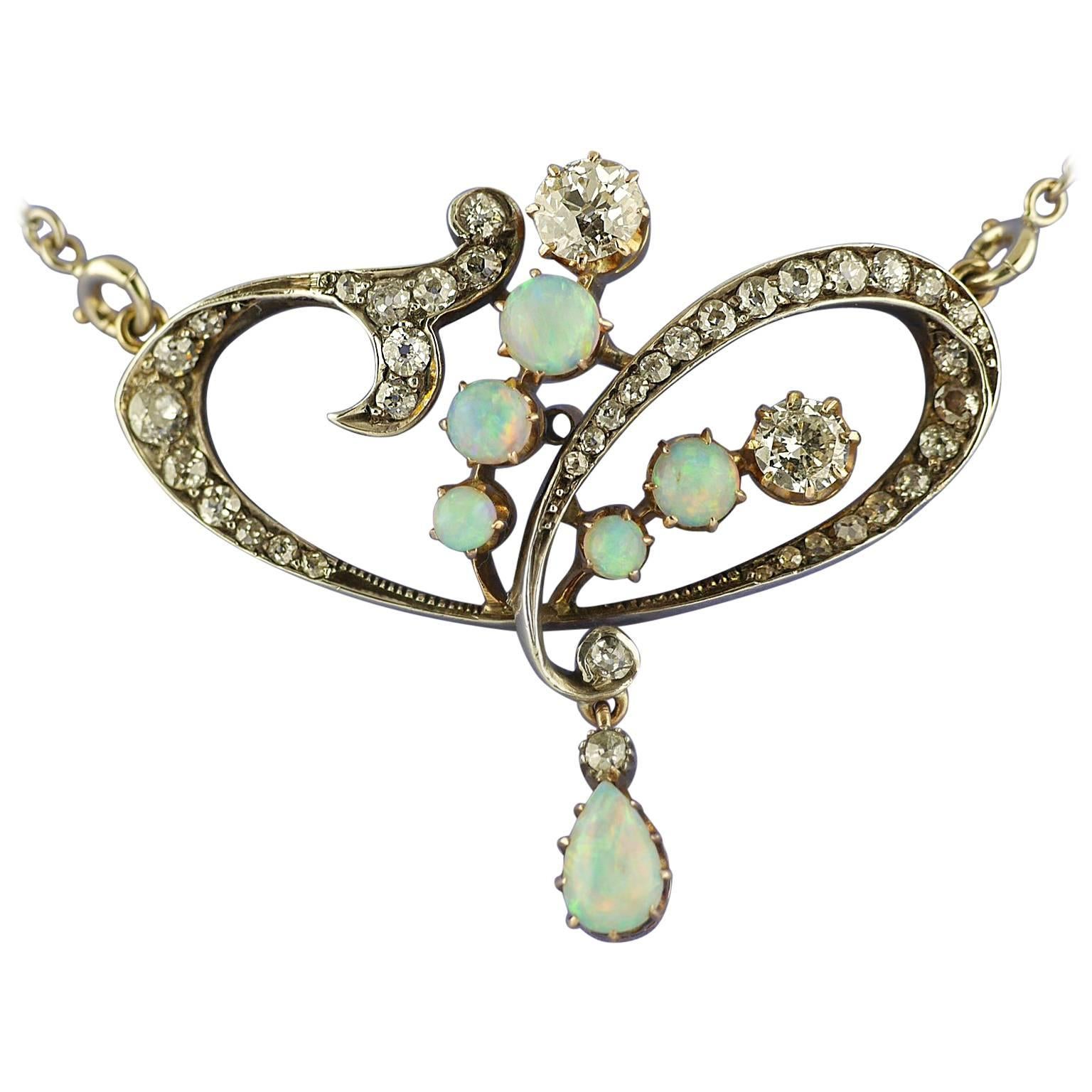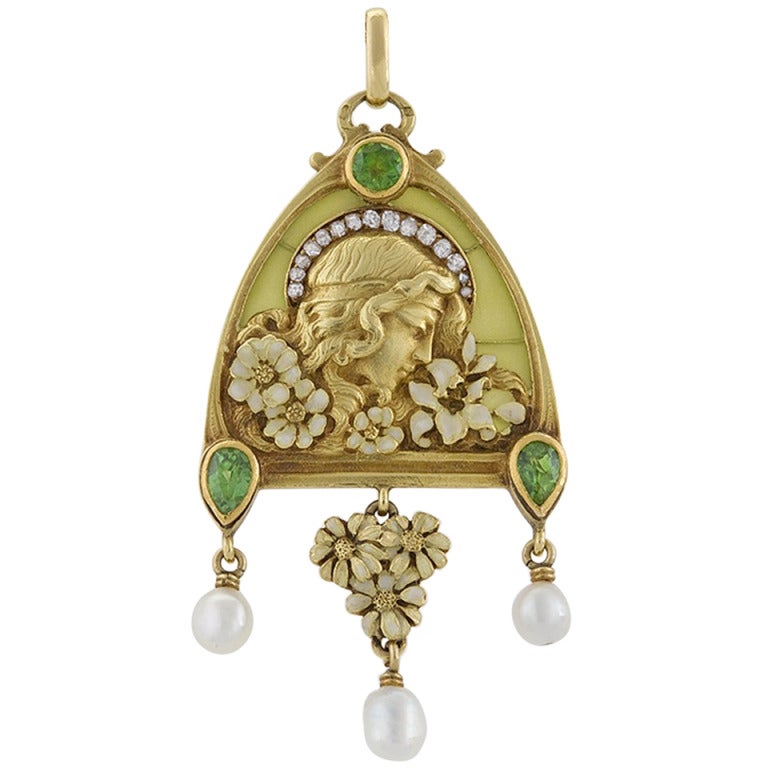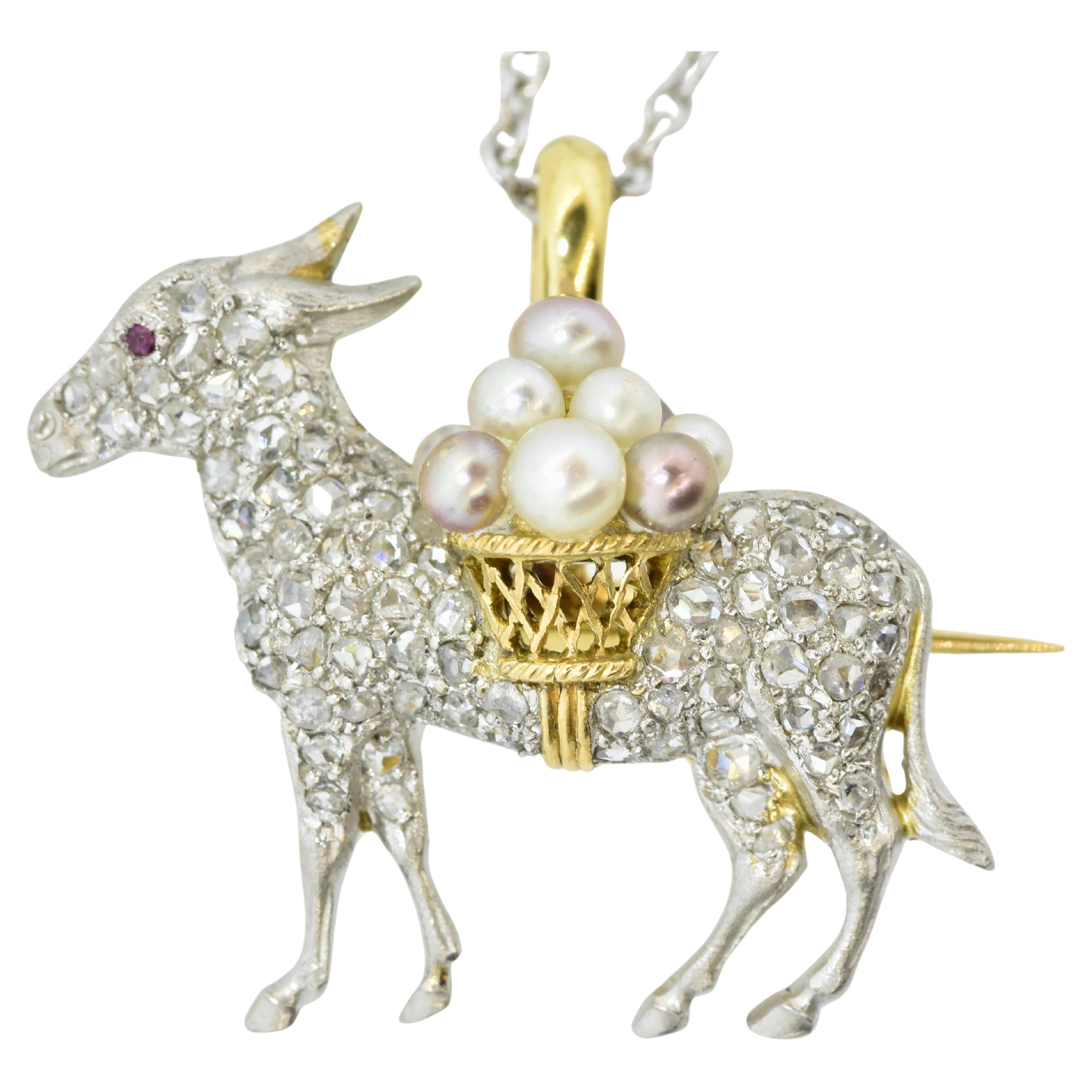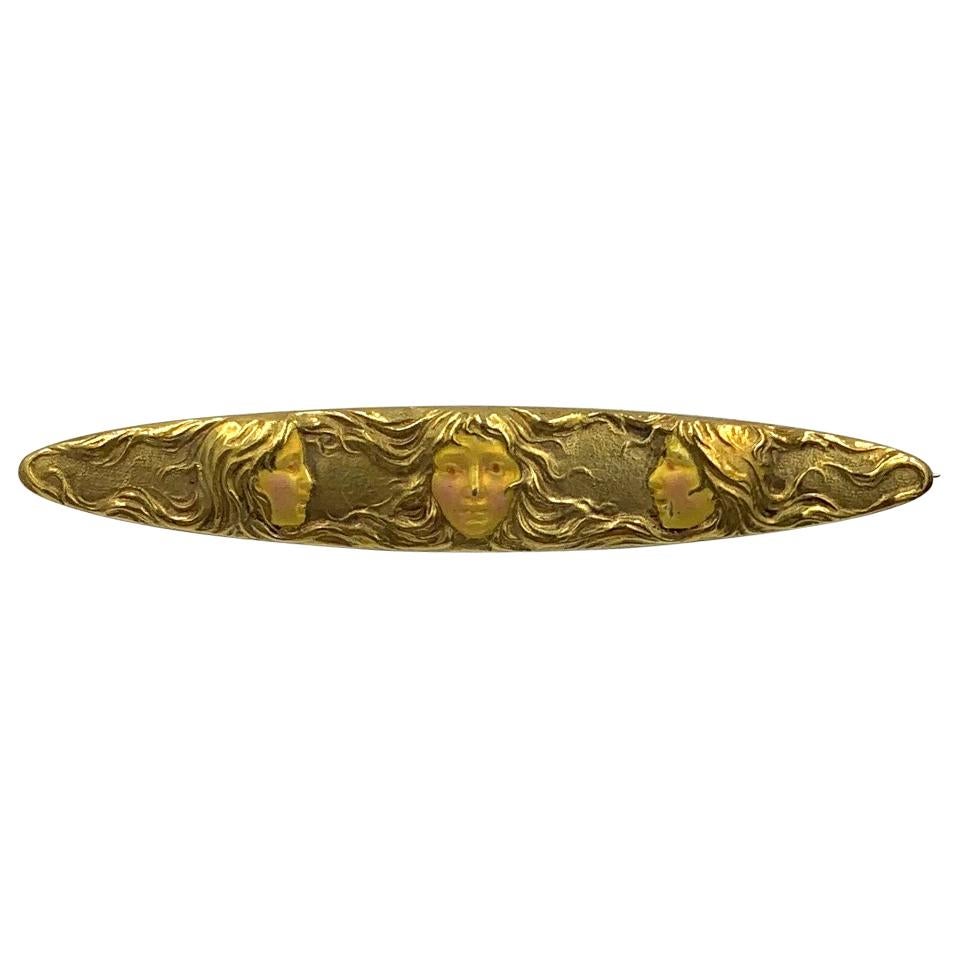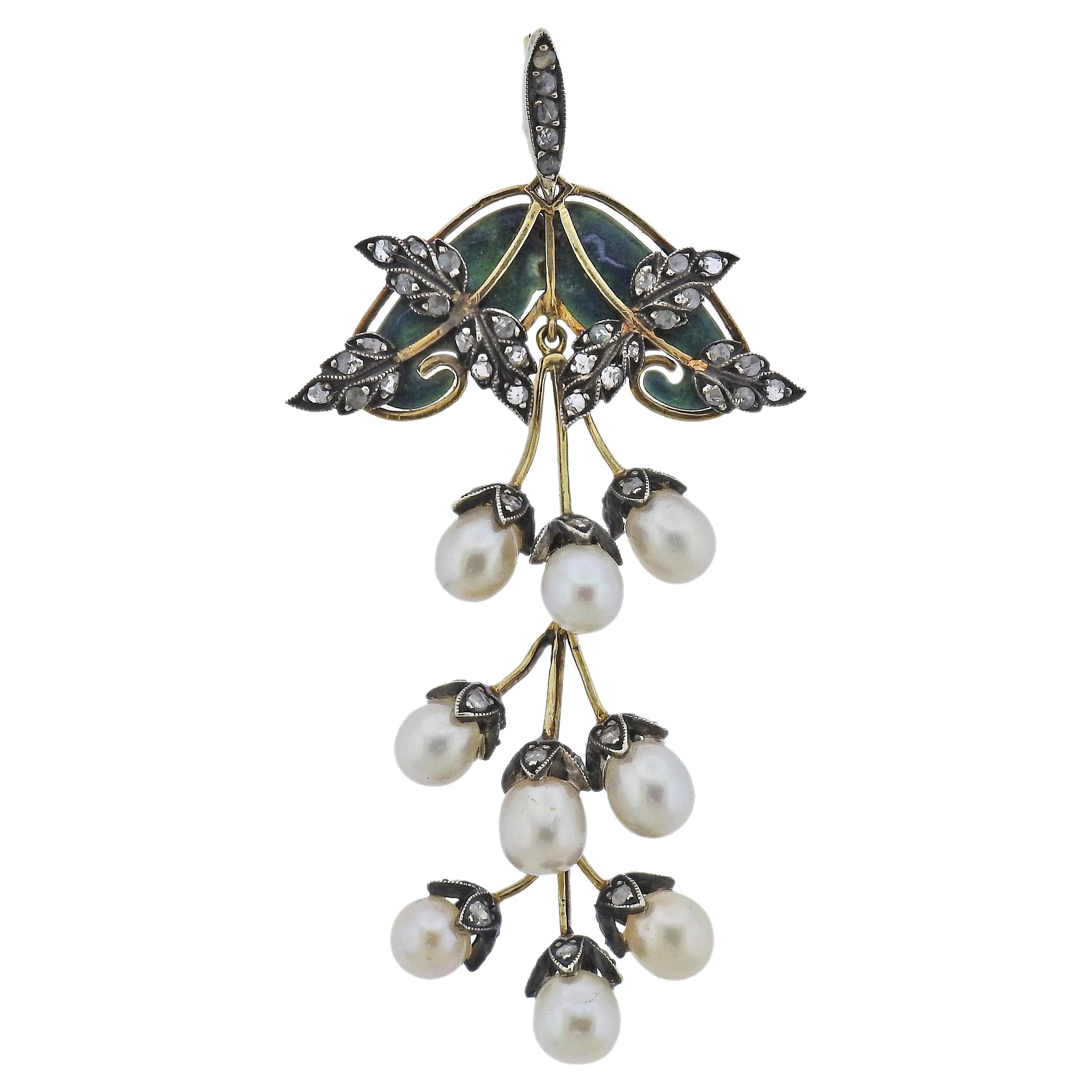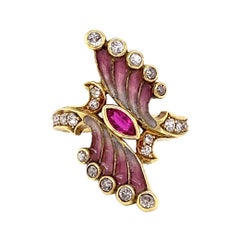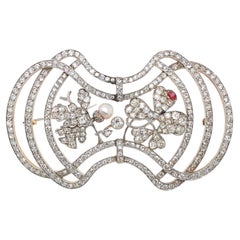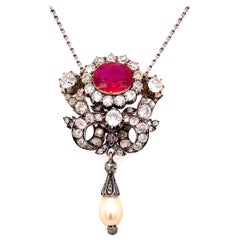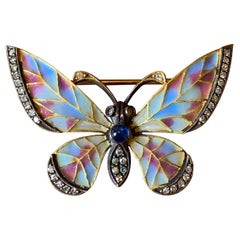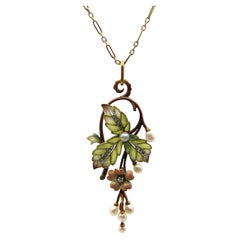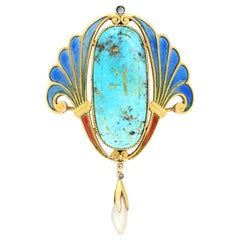
Art Nouveau Turquoise Pearl and Diamond Plique-a-Jour Brooch, circa 1900
View Similar Items
Want more images or videos?
Request additional images or videos from the seller
1 of 8
Art Nouveau Turquoise Pearl and Diamond Plique-a-Jour Brooch, circa 1900
About the Item
- Metal:
- Stone:
- Stone Cut:
- Weight:13 g
- Dimensions:Height: 2.33 in (59 mm)Width: 1.58 in (40 mm)
- Style:
- Period:
- Date of Manufacture:1900s
- Condition:Additions or alterations made to the original: The brooch pin was probably added to this piece. Wear consistent with age and use.
- Seller Location:Idar-Oberstein, DE
- Reference Number:Seller: ENTP2020000271stDibs: LU65410104532
About the Seller
5.0
Vetted Seller
These experienced sellers undergo a comprehensive evaluation by our team of in-house experts.
Established in 1980
1stDibs seller since 2014
138 sales on 1stDibs
Typical response time: 6 hours
More From This SellerView All
- Art Nouveau Plique a Jour Enamel Ruby and Diamond Ring, ca. 1900sLocated in Idar-Oberstein, DEArt Nouveau Plique-a-Jour Enamel Ruby and Diamond Ring, ca. 1900s A beautiful Art Nouveau ring from the 1900s, centring a marquise shaped ruby and featuring beautiful gradient windo...Category
Antique Early 1900s Unknown Art Nouveau Cocktail Rings
MaterialsDiamond, Ruby, Enamel, 18k Gold
$7,000 Sale Price23% OffFree Shipping - Diamond Pearl and Ruby Oak Leaf and Trefoil Clover Brooch, Art Nouveau, ca 1910sLocated in Idar-Oberstein, DEA large diamond, pearl and ruby Art Nouveau brooch in platinum and yellow gold, ca. 1910s. It has a beautiful design and with the depiction of an oak leaf and trefoil clover it car...Category
Vintage 1910s Art Nouveau Brooches
MaterialsPearl, Ruby, Diamond, Yellow Gold, Platinum
$14,000Free Shipping - Victorian Natural Burma Ruby, Diamond and Pearl Pendant, 1880sLocated in Idar-Oberstein, DEAn important Victorian pendant with a ruby, diamond and a pearl, 1880s. The big centre stone is a rare natural and not heat treated Burmese ruby weighing 4.32 carats, certified by a ...Category
Antique 1880s Victorian Pendant Necklaces
MaterialsDiamond, Pearl, Ruby, Gold, Silver
- Theodor Fahrner Jugendstil Art Nouveau Enamel Gold BroochBy FahrnerLocated in Idar-Oberstein, DEA beautiful and rare 18k gold brooch by Theodor Fahrner, in a rectangular gateway design, with a pearl and a red enamelled ring around it in the center, hinged to a diamond-set column and surrounded by curtain-shaped gold work. Theodor Fahrner was the most famous Jugendstil jeweller from Germany. In 1900 he won the Silver Medal for Jewellery at the World Exhibition in Paris, and subsequently led his family's business to new heights during the Jugendstil era...Category
Antique Early 1900s German Jugendstil Brooches
MaterialsDiamond, Natural Pearl, 18k Gold, Enamel
- Victorian Natural Pearl Diamond Swan BroochLocated in Idar-Oberstein, DEA very unique and rare antique brooch from the 1880s. Set with an important natural saltwater pearl button of 42 grains (with DSEF certificate), ...Category
Antique Late 19th Century Unknown Victorian Brooches
MaterialsDiamond, Natural Pearl, Gold Plate
- Victorian Gold Diamond Bow Brooch Pendant, 1880sLocated in Idar-Oberstein, DEA bow shaped diamond brooch/pendant from the Victorian era, ca. 1880s. It is studded with old European and cushion cut diamonds, weighing circa 5 carats.Category
Antique 1880s British Victorian Brooches
MaterialsDiamond, Gold, Silver
You May Also Like
- Art Nouveau 1890 Plique a Jour Pendant Brooch in 18kt Gold Diamonds Pearls RubyLocated in Miami, FLArt Nouveau Plique à jour pendant brooch. A exceptional piece, created during the Art Nouveau period, back in the 1890. Surely It was crafted in Austria or Germany with the difficul...Category
Antique 1890s Austrian Art Nouveau Pendant Necklaces
MaterialsDiamond, White Diamond, Pearl, Natural Pearl, Ruby, Gold, 18k Gold, Yell...
$7,000 Sale Price / set20% OffFree Shipping - Plique-a-Jour Enamel Sapphire Diamond Butterfly Brooch Art Nouveau 18 Karat GoldLocated in New York, NYThis is a wonderful and rare Museum Quality Art Nouveau Brooch in the form of a Butterfly or Moth. The magnificent Butterfly has exquisite Plique-a-jour enamel wings, a fine blue Sa...Category
Antique Late 19th Century Unknown Art Nouveau Pendant Necklaces
MaterialsDiamond, Sapphire, Gold, Enamel, 18k Gold, Yellow Gold
- 15k Gold Art Nouveau Plique-à-jour Diamond and Pearl NecklaceBy Mappin BrothersLocated in Venice, CAA classic Art Nouveau design, this 15k rose gold necklace features stunning plique-à-jour, Rose Cut diamonds, and beautiful pearls. The centerpiece of the necklace is articulated, hinged in two places so that the flower and pearl drops dangle freely. Three plique-à-jour leaves are translucent—the loveliest matte soft green that fades into subtle purple highlights, clearly done by a master. Each cell of the leaf is filled with plique, with a white metal (platinum or white gold) creating contrast in the center of the leaf. Inside are a channel of bead set Rose Cut diamonds. A flower is suspended from the leaves, with multi-tones of peach to pale yellow that glow against the gold, with a prong-set diamond as its piston. The design work loops over, turning the bail into a scrolling foliate. The 15k gold appears rosy, as it has an incredible patina that shimmers with various hues of pink, gold, and green. “Plique-à-jour” translates from French as “letting in daylight” and is a charming technique used in jewelry throughout the 20th century. To create this effect, colored, transparent enamel is suspended between gold backless cells to allow light to illuminate the piece with vibrant colors, similar to a stained glass window. The flower hangs from a 15k gold classic alternating link chain...Category
Antique Early 1900s British Art Nouveau Pendant Necklaces
MaterialsDiamond, Pearl, 15k Gold, Rose Gold
- Art Nouveau Diamond Opal Pendant/Brooch, circa 1900Located in London, GB18ct gold & silver set Art Nouveau Diamond Opal Pendant/Brooch dated circa 1900 Five round opals with an articulated pear shaped opal drop, very well matched with lively play of colours and iridescence in reds, greens, blues and gold. Set in 18 carat yellow gold claw collets Two main transitional cut (old mine) diamonds 0.70ct. Mix of old mine and rose cut diamonds in an 18 carat yellow gold with “silver Set” channel setting , approx 1 ct total. G/H/I, VS2-SI2. Total diamond weight: approx 1.7carats Setting diamonds in gold with a thin layer of silver, “silver set”, was a technique used in the Georgian/Victorian/Art Nouveau period as white coloured gold and platinum were not yet available. A very thin layer of silver was applied to the gold, on which the diamonds were set, to show them off to their best advantage (as the yellow would reflect and distort the white colour of the diamonds). The Art Nouveau period was a short lived but worldwide movement which reached its peak at the end of the 19th Century and the first decade of the 20th Century. It had its roots in the Pre Raphaelite and Arts and Crafts movements in Britain in the 1860’s. Artists, such as William Morris, took their inspiration from the flora and fauna of nature and rejected the mass industrialisation and mechanisation of the Victorian age. Art Nouveau continued with this theme and has a distinctive appearance with soft, curved shapes and lines and often depicted natural designs such as flowers, birds and the female form. Before the Art Nouveau period, the emphasis had been to design pieces with an emphasis on gem stones, diamonds, rubies emeralds etc. However, during the Art Nouveau period, jewellers adopted the idea of using other semi–precious stones “from nature” such as agate, garnet opal, moonstone, aquamarine and experimented with a wide variety of new techniques e.g. enamelling. The “New Art” style became a worldwide movement encompassing all disciplines of the arts, and world class artists as far afield as Gaudi with his “modernisme” architecture in Spain, Louis Comfort Tiffany in New York with objects, Galle Glass in France and the Liberty & Co Archibald Knox designs in Britain, Jugendstil in Northern Europe and Faberge in Russia. The movement flared brightly but briefly and by 1910 it was already going out of style to be replaced by Art Deco. In fitted period box. Detachable 18ct brooch...Category
Antique Early 1900s British Art Nouveau Pendant Necklaces
MaterialsWhite Diamond, Opal, Diamond, 18k Gold, Yellow Gold, Silver
- Art Nouveau Diamond Opal Pendant/Brooch, circa 1900Located in London, GB18ct gold & silver set Art Nouveau Diamond Opal Pendant/Brooch dated circa 1900 Five round opals with an articulated pear shaped opal drop, very well matched with lively play of colours and iridescence in reds, greens, blues and gold. Set in 18 carat yellow gold claw collets Two main transitional cut (old mine) diamonds 0.70ct. Mix of old mine and rose cut diamonds in an 18 carat yellow gold with “silver Set” channel setting , approx 1 ct total. G/H/I, VS2-SI2. Total diamond weight: approx 1.7carats Setting diamonds in gold with a thin layer of silver, “silver set”, was a technique used in the Georgian/Victorian/Art Nouveau period as white coloured gold and platinum were not yet available. A very thin layer of silver was applied to the gold, on which the diamonds were set, to show them off to their best advantage (as the yellow would reflect and distort the white colour of the diamonds). The Art Nouveau period was a short lived but worldwide movement which reached its peak at the end of the 19th Century and the first decade of the 20th Century. It had its roots in the Pre Raphaelite and Arts and Crafts movements in Britain in the 1860’s. Artists, such as William Morris, took their inspiration from the flora and fauna of nature and rejected the mass industrialisation and mechanisation of the Victorian age. Art Nouveau continued with this theme and has a distinctive appearance with soft, curved shapes and lines and often depicted natural designs such as flowers, birds and the female form. Before the Art Nouveau period, the emphasis had been to design pieces with an emphasis on gem stones, diamonds, rubies emeralds etc. However, during the Art Nouveau period, jewellers adopted the idea of using other semi–precious stones “from nature” such as agate, garnet opal, moonstone, aquamarine and experimented with a wide variety of new techniques e.g. enamelling. The “New Art” style became a worldwide movement encompassing all disciplines of the arts, and world class artists as far afield as Gaudi with his “modernisme” architecture in Spain, Louis Comfort Tiffany in New York with objects, Galle Glass in France and the Liberty & Co Archibald Knox designs in Britain, Jugendstil in Northern Europe and Faberge in Russia. The movement flared brightly but briefly and by 1910 it was already going out of style to be replaced by Art Deco. Detachable 18ct brooch...Category
Antique Early 1900s British Art Nouveau Pendant Necklaces
MaterialsDiamond, White Diamond, Opal, 18k Gold, Yellow Gold, Silver
- Art Nouveau Hydrangea Plique a Jour PendantLocated in New York, NYArt Nouveau Hydrangea Plique a Jour Pendant set in silver with hand painted hard enamel florals and plique a jour leaves. Realistically modeled silver branch with a enamel bloom belo...Category
Antique Early 1900s German Art Nouveau Pendant Necklaces
MaterialsSterling Silver
